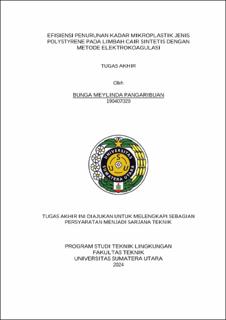| dc.contributor.advisor | Hafni, Kartini Noor | |
| dc.contributor.advisor | Sari, Yasmine Anggia | |
| dc.contributor.author | Pangaribuan, Bunga Meylinda | |
| dc.date.accessioned | 2024-08-15T06:37:16Z | |
| dc.date.available | 2024-08-15T06:37:16Z | |
| dc.date.issued | 2024 | |
| dc.identifier.uri | https://repositori.usu.ac.id/handle/123456789/95458 | |
| dc.description.abstract | Onetypeofplasticpolymerthat is asourceofmicroplastics is polystyrene. Increasing levels ofmicroplastics in waters can haveanegativeimpact ontheenvironment and living creatures. One processing method that can be used to reduce microplastic levels is the electrocoagulation process. This research was carried out with the aim offindingout the efficiencyofreducinglevels ofpolystyrenemicroplastics usingbatch system electrocoagulation processingandlookingat the effect ofvariations in distancebetweenelectrodes and variations in electrical voltage. From the research results, itwas foundthat the greatest efficiencyin reducinglevels ofpolystyrenetypemicroplastics was99.92% at an electrical voltage of 1 Volt with an electrode distance of 2 cm. | en_US |
| dc.language.iso | id | en_US |
| dc.publisher | Universitas Sumatera Utara | en_US |
| dc.subject | Electrocoagulation | en_US |
| dc.subject | Polytyrene | en_US |
| dc.subject | Efficiency Removal | en_US |
| dc.subject | SDGs | en_US |
| dc.title | Efisiensi Penurunan Kadar Mikroplastik Jenis Polystyrene pada Limbah Cair Sintetis dengan Metode Elektrokoagulasi | en_US |
| dc.title.alternative | Efficiency of Reducing Levels Ofpolystyrene Typemicroplastics in Synthetic Liquid Waste Using The Electrocoagulation Method | en_US |
| dc.type | Thesis | en_US |
| dc.identifier.nim | NIM190407020 | |
| dc.identifier.nidn | NIDN0021046304 | |
| dc.identifier.nidn | NIDN0023108903 | |
| dc.identifier.kodeprodi | KODEPRODI25201#Teknik Lingkungan | |
| dc.description.pages | 61 Pages | en_US |
| dc.description.type | Skripsi Sarjana | en_US |


